All Aboard!
It was necessary to include clothes for varying climates which would be encountered along the way. December temperatures could be below freezing in Denver and the Rockies to warm in Southern California and Texas. The week before the trip had been spent in packing, trying to prepare for all contingencies, including the fact that invitations had been coming in from alumni groups, civic organizations, and people who were just fans, all along the route, hoping to host functions for the team while it was in town.
Proper attire was going to be necessary.
Hump Tanner told one reporter that Terry Snowday was packing enough clothes to outfit the entire cast of a D.W. Griffith movie, and if you look at the photographs taken on the trip, you'll see that Terry was indeed a very dapper guy.
Centre had decided that those who would be included on the journey were the letter winners who had been announced at the recent banquet. There were 22 players plus Johnny McGee, the team manager, who had received the gold "C." The 5 additional spots on the 14 section Pullman, with its 28 berths, were occupied by Uncle Charlie, Tiny Thornhill, Carl "Swede" Anderson, trainer, George Joplin, reporter and great booster, who was going along not only to report for his paper, but also to handle press relations for the team, and faculty athletic representative, Albert Eugene Porter.
( A section could house 4 people if the upper and lower berths were each occupied by 2 people, but each person had a private bed on the trip with the seniors having first choice of the lower berths. )
The send-off for the team on the evening of December 16 was greater even than the rousing celebration that occurred when the Colonels left for the Harvard game.
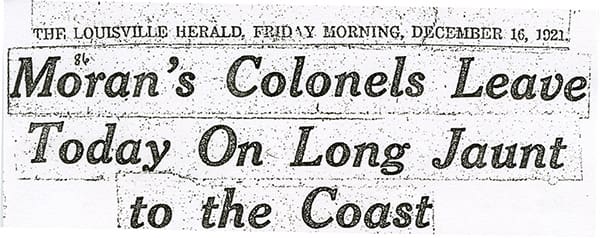
Papers in Kentucky had great interest in the great trip west
It was like they going on a Grand Tour of Europe, or something like that. They were going to be gone nearly 3 weeks, and everyone wanted to see them off. They all had leather suitcases with stickers that were from so many of the trips where they had been- from hotels and trains and places like Niagara Falls.
Some Louisville friends of the team shipped steamer trucks over to Danville for the team to use. Steamer trunks were big leather and wooden trunks which opened up and were like a closet and wardrobe combined. You could hang clothes in them, and they had drawers where you could put shirts and underwear and shoes.

Steamer trunk used for long-term travel during the era
You dressed when you traveled back then. Now, people just dress casually or worse, but not back then. You dressed for the occasion, and the guys always looked great whenever they went anywhere.
The team left when Christmas vacation began, on a late Friday afternoon, so any students who lived in Lexington or Louisville, or even west toward St. Louis, anywhere that the train was going, had tickets to go to their homes for Christmas vacation.
Howard and I couldn't go because in order to get home to Elizabethtown, we had to take the L&N which we caught at Junction City which is just south of Danville, instead of the Southern which the team left on. Cousin Ella would have her chauffeur drive us to Junction City which just took a few minutes, even in those days when the roads weren't so good.
The Danville brass band played, George Swinebroad led cheers, there was a lot of hugging and wishing the team well, and then, I'll never forget, the whistle blew and blew and the team waved from the windows, and slowly, they pulled away, and they left with every person at the station so proud that our school was going on this great adventure.
The Pullman car that the team traveled in was named the "Cowdray," named for Lord Cowdray, the British-born engineer who had built the Hudson River Tunnel which connected New York and New Jersey.
The train stopped in Lexington for a brief layover where a crowd once again was at the station to cheer on the team. Then it was west to Louisville where they were met again by a large, enthusiastic group of supporters, this time at the Seventh Street Station. After getting off briefly to meet with the fans, the players headed for their berths, prepared by the porter while they mingled on the platform.

A stopover in Louisville
Next stop- St. Louis. Time of arrival-7:10 AM., on December 17. The St. Louis University athletic officials had organized a breakfast for the team during the 2 hour layover while the "Cowdray" was to be hooked onto a westbound train.
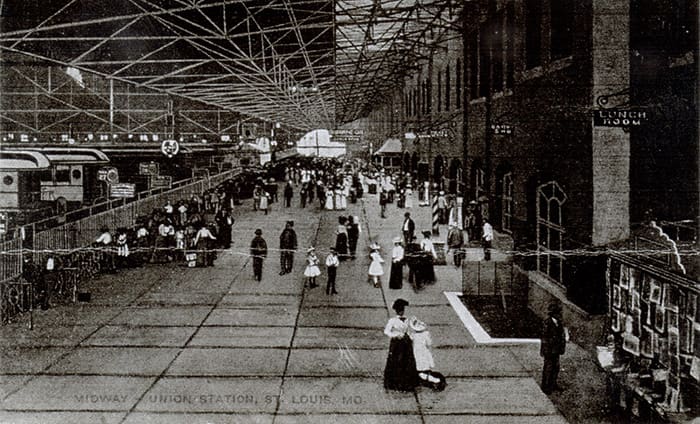
The team was met at the St. Louis Union Station

Breakfast was to be hosted by a contingent from St. Louis University while the Cowdray was uncoupled from the Southern Railroad to the Wabash Railroad for the next leg of the trip.
The meal was to be served in the massive St. Louis Union Station. The terminal, built in 1894, had a restaurant which opened in 1895 to passengers and the public operated by the famous Fred Harvey organization, staffed by attractive young ladies called "Harvey Girls." The "Girls" were a hit with the team, and, it was said that the squad made an equally favorable impression on the pretty waitresses.
Before going to the breakfast, each of the team members had to experience a phenomenon in the huge Grand Lobby where a towering arch, 40 feet wide at its base, allowed a person to whisper while facing the wall, and another individual, facing the opposite wall, could clearly hear what was said.
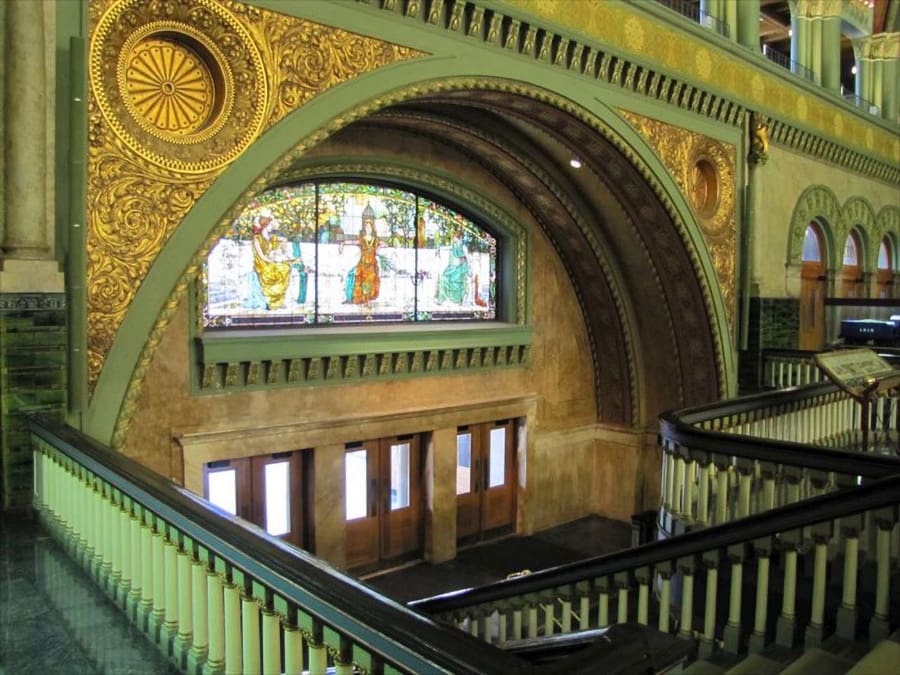
The "Whispering Arch" at the entrance of the Grand Lobby
"Hey, Terry," Army barely whispered. The startled Snowday turned around, certain that the captain was standing just behind him, not way across the entrance.
Of course, everyone had to experience the "Whispering Arch."
"Nothing like that in Danville," Bill James said to Jop, who sent news about everything that happened on the trip back to the "Messenger" in Danville.
Ward Goodloe, representing a group known as the "Kentucky Society of St. Louis," had wired Danville just before the team left for the West Coast, offering to also host a breakfast. When his organization received a return wire that the Colonels were already committed, the members came to the station and met with the team when they left the dining room, and walked them back through the train shed to the "Cowdray," sending them off with loud cheers as the train pulled out just after 9:00 AM. on the next leg of the trip.
Over the Wabash Railroad they traveled all day, heading west on the 250 miles of track to Kansas City. In the afternoon, the "Cowdray" was switched to a Union Pacific train to make the 400 mile jaunt through Kansas, mainly traversed while the Colonels slept for their second night.
After breakfast, they crossed the Kansas border and entered the plains of Colorado. There was a mid-morning stop in Hugo, elevation 4,943 feet, to allow the big engine to take on coal and water, and the Colonels disembarked in order to run a few wind splints.
It was 1:30 in the afternoon, Sunday, December 18, when they pulled into Denver's beautiful Beaux-Arts style, Union Station, rebuilt in 1894 after the previous terminal was destroyed by fire. When the Colonels reached the interior of the massive lobby, they were overwhelmed to see more than 400 people waiting, each crowding in trying to personally greet them.

A large crowd awaited the Colonels in Denver
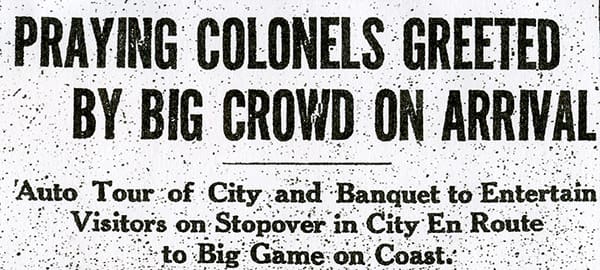
The "Rocky Mountain News" had a reporter assigned to spend the day with the team.
The famous yell of the Colorado mines, "Rip 'em up, tear 'em up, give them h... Centre," was transposed to fit the occasion, and the Centre College booster's cheers thundered in the ears of the visitors as they were pushed, pulled, and shoved by the admiring crowd, swelled to several hundred, to the station exit.
Following their arrival, the Kentuckians were guests of the sports editor of this paper in an automobile tour of Denver. In the big enclosed limousines of the Denver Cab Company, the Southerners visited the Civic Center, City and Chessman Parks, and the residential and other scenic districts of the city.
After the tour of the city, the limousines returned to the heart of the city and let the team out at the ornate Denver Athletic Club where they would stay for the night. The athletes changed into workout clothes, did some exercising, had a welcomed shower, and returned to their rooms to get ready for the evening.
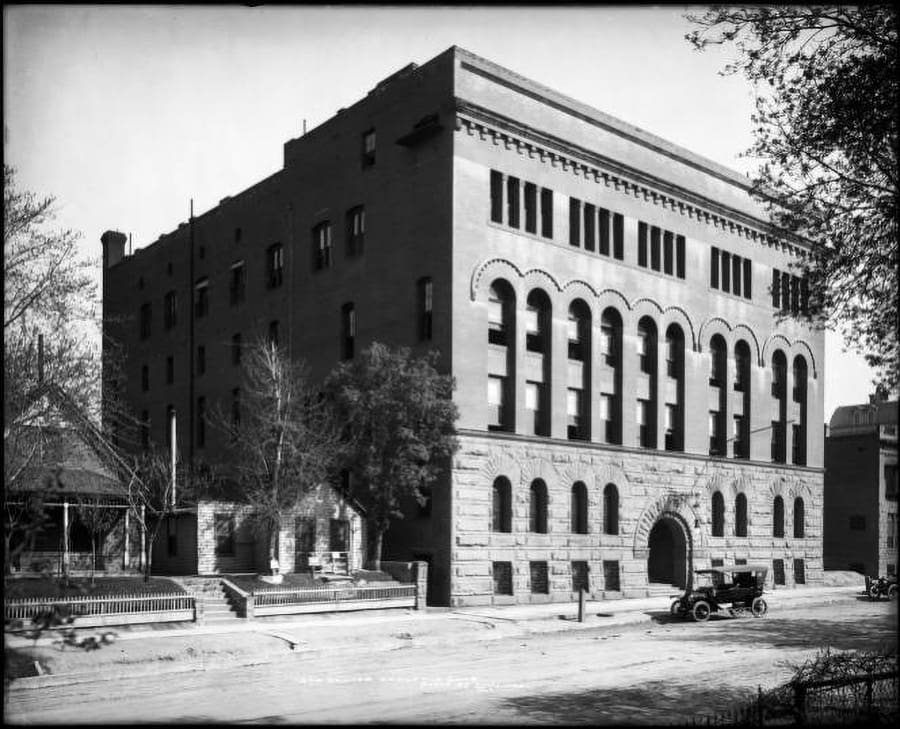
Denver Athletic Club, the overnight accommodation
Once again, limousines were lined up outside the Club to transport the Colonels to the Albany Hotel at the corner of Stout and 17th Street.
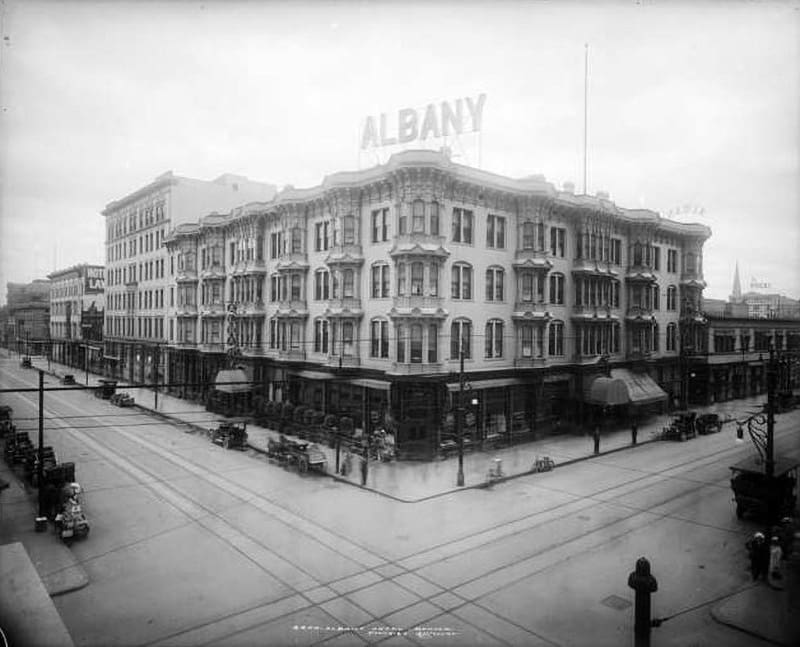
Albany Hotel, Denver built in 1885 after the 1879 Colorado mining boom brought new wealth to the city
The official reception included many of Denver's dignitaries along with friends and alumni of Centre, reporters and photographers.
"Here's to Uncle Charlie .... "
"Here's to the Gold and White.... "
"Here's to the Centre spirit...."
As soon as the dinner and toasts ended, the team again piled into the limousines for a night at the Orpheum Theater.

The team was entertained at the Orpheum
The performance was interrupted by the crowd standing and cheering the Kentuckians before the actors could continue.
The next morning, the "Cowdray" was connected to a Denver and Rio Grande passenger train for the trip over the Rockies to Ogden, Utah. For this part of the trip, the Colonels' car was placed in front of the observation car so that the team and other passengers could enjoy the scenery from the rear of the train as it slowly wound its way up from the flatness of Denver through the towering peaks.
Most of the team had never been in the mountains, and some hadn't seen any significant snow which began to become more evident as they reached a higher elevation.
Some 25 miles west of Denver, the conductor came into the car and told everyone to watch for water running along the side of the train. "You'll see water running one way, and then water running the other way. You're going over the Continental Divide. Water going that way," and he pointed to his left, "will eventually end up in the Pacific Ocean, and water running the other way," and he pointed out a stream on the right, "will end up in the Gulf of Mexico, or Atlantic Ocean."
There was a lot of discussion about that fact, and more than a little disbelief, but Uncle Charlie confirmed what the conductor had told them.
"Well, if you say so, Unc.... "
The train took the Royal Gorge route, going over the highest mainline track in the country at the 10,240 foot Tennessee Pass. It was a slow, twisting, wonderful ride, punctuated by another overnight segment, and the "Cowdray" didn't reach its next goal, Ogden, Utah, until 1:30 in the afternoon on Tuesday, December, over 29 hours after pulling out of Denver.
Ogden was the end of the line for the Rio Grande, and there was a 40 minute layover awaiting the Southern Pacific's crack train, the "Overland Limited" which had originated in Chicago.

Scenic route of the Overland Limited which the Colonels enjoyed through Nevada
The railroads had opened up the West with the meeting of the Central Pacific, originating in Omaha, and the Union Pacific, originating in Sacramento, at Promontory Summit, northwest of Ogden. The "Golden Spike" which joined the two lines was driven on May 10, 1869.
The original transcontinental route skirted around the northern boundary of the Great Salt Lake. However, under the leadership of E.H. Harriman, plans were drawn up for the railroad to actually cross the lake, and in 1904, 103 miles of new track were completed which included 15 miles of fill and an incredible 23 miles of wooden trestle, and this is the route which the team took after having pulled out of Ogden.
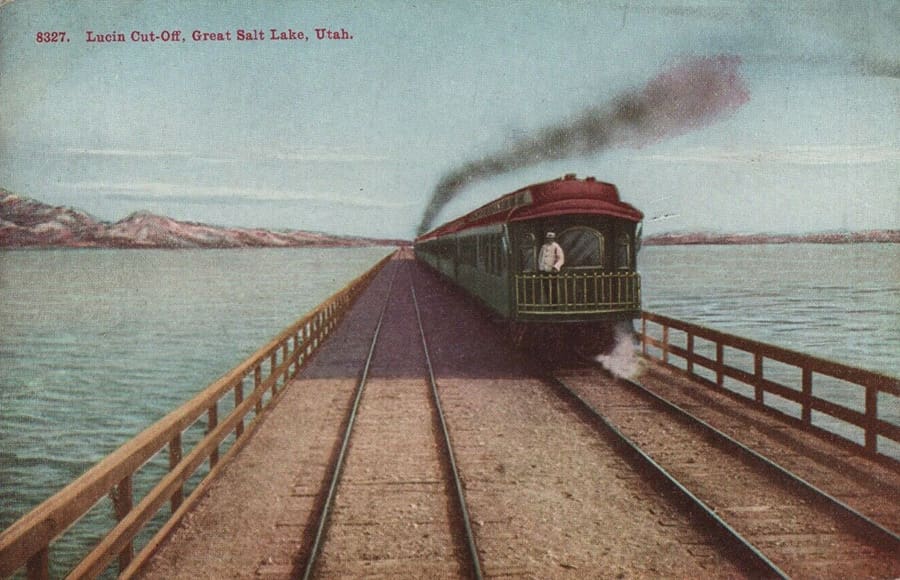
Over the great Salt Lake
The "Overland Limited" entered Nevada 9 miles west of Lucin, Utah, and continued across the state throughout the afternoon and evening. Once across the state line into California, the train journeyed through the Donner Pass, in the northern Sierra Nevada, and then began the descent to Sacramento, going down a grade of 7,000 feet in 100 miles.
After a short stop in California's capital, the final leg of slightly over 100 miles found the "Limited" in Oakland, where the "Cowdray" was uncoupled and placed on a siding, with the rest of the train being pulled onto a Southern Pacific ferry, the "Solano," for transport across the Bay into San Francisco.
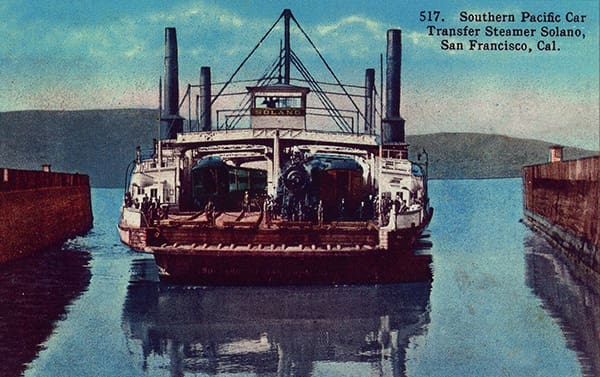
Across San Francisco Bay from Oakland to San Francisco on the "Solano"
( Until 1930, the Southern Pacific brought passenger trains into San Francisco via large ferries, and the "Solano" was the largest of all. It was 410' X 110' and had 4 tracks. Not only could it convey two entire passenger trains, but a switch engine as well. Freight trains went around the Bay on a land line. )
The Colonels rode the ferry across the Bay, marveling at the skyline of San Francisco which lined the opposite shore. When they stepped on land again, it was 2:30 in the afternoon, December 21. Allowing for the 3 hour time differential, they had been gone exactly 5 days since leaving Danville, and they were still over 500 miles from San Diego.
At the pier awaiting Uncle Charlie and the squad was the athletic director of Stanford University, Walter B. Powell, the secretary of the Pacific Coast Football Association, J.R. Klanwans, and the former coach of the Owensboro High School team back in Kentucky, Bob Evans, who had been Stanford's coach in 1919.

The three were going to be the hosts of the Kentuckians while they were in the Bay Area. Evans was particularly interested in greeting Owensboro natives, Hump Tanner, Tom Bartlett and Terry Snowday. Accompanying the official committee was a large group of transplanted Kentuckians including Centre graduates, and the usual reporters and photographers who met the Colonels wherever they went.
Photographers from the San Francisco "Call and Post" clicked away, and the morning edition, on December 22, published a picture under the large heading and caption:
CENTRE COLLEGE VISITS SAN FRANCISCO
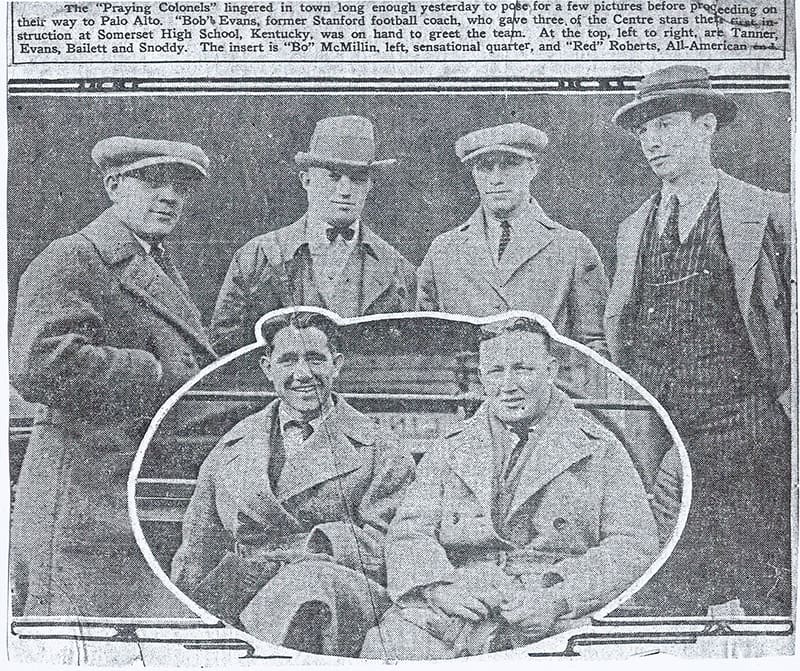
Photo published in the San Francisco "Call and Post" on the morning of December 22, 1921. The caption incorrectly states that Bob Evans had given the trio of Hump Tanner, Tom Bartlett and Terry Snoddy ( Snowday ) their start at Somerset High when it was actually Owensboro High School in Kentucky. Also, Bartlett was spelled "Bailett." Bo and Red Roberts are in the insert.
Bo and Red Roberts were photographed together.
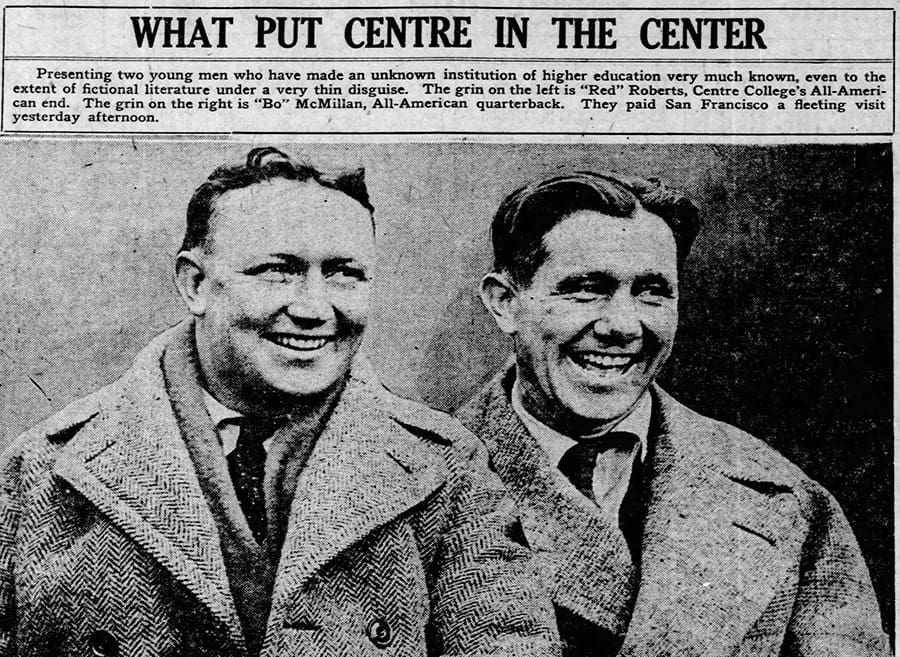
Red and Bo in San Francisco
The San Francisco "Chronicle" had a 4-column wide, large photograph in its morning issue.
The photo had the entire team and those who greeted them, and the inset identified, "Bud" Jones, All-American, Red Roberts and the, "famed quarterback, Bo McMillin."
Local reporter Fred E. Farmer filed a story under the heading:
FAMOUS CENTRE FOOTBALLERS, COACH, COME TO SAN FRANCISCO
COLONELS FROM KENTUCKY MOST IMPRESSIVE LOOKING BUNCH OF HUSKIES
The Colonels from Centre College, with Coach Charlie Moran, arrived in San Francisco yesterday on the "Overland Limited" of the Southern Pacific. A fine, husky bunch of football men are these sons of Kentucky- the kind who can be singled out in a crowd at once.
A person is impressed with them, but not in the manner to consider them the team that went to Cambridge and conquered Harvard. They look more of the freshwater college variety, but their football record is their credential. And it is some hardy credential.
Bo McMillin, perhaps the most talked about football player today, is a quiet chap, speaks with a typical Southern drawl, and wears gloves. He is not that tall, but a peek at the width of his shoulders speaks of the tremendous driving power for which he is noted.

Colorized photo of Bo in San Francisco
Bo is built rather close to the ground, and in street clothes looks almost meek. But according to his teammates and his record, this mien of meekness is left in the dressing room, and Bo is a regular "eat-'em-up" man on the football field.
The majority of the Centre men are short and husky. Jones, a guard, looks to weigh about 150, but lays claim to 185. It was that way all along the line. Snowday, the great Centre halfback, is long and rather thin, but according to his teammates, hits the line like a ton of bricks.
Red Roberts, an end of the Colonels, picked by Walter Camp for the first All-American team, is a giant of a man. Red weighed 235 pounds when he left Kentucky, and he certainly looks like it. He resembles his brother All-American end, Brick Muller of California. Both are red-headed, freckle-faced, and husky enough to tear a backfield man in two.
All of the boys are extremely mild-mannered. And perhaps the most quiet of the bunch is the captain of the team, Norris "Army" Armstrong. And then there is Uncle Charlie Moran himself. Charlie is a National League umpire in the baseball season, and when asked to pose for a photograph, jokingly said umpires are not accustomed to having their pictures taken. He is always on the lookout for his team, and every man on the Centre team swears by him.
After satisfying the press and thanking the fans who came to greet them, the Colonels boarded buses for a tour of the downtown area. It had only been 15 years since the devastating San Francisco earthquake, but the city had been rebuilt even more beautifully than it had appeared before the catastrophe.
The buses wound up Nob Hill so that the mansions, rebuilt after the earthquake, could be appreciated, and the players got out and walked around, taking in the grandeur that even exceeded what they had experienced in touring the Back Bay of Boston.

Nob Hill Mansions
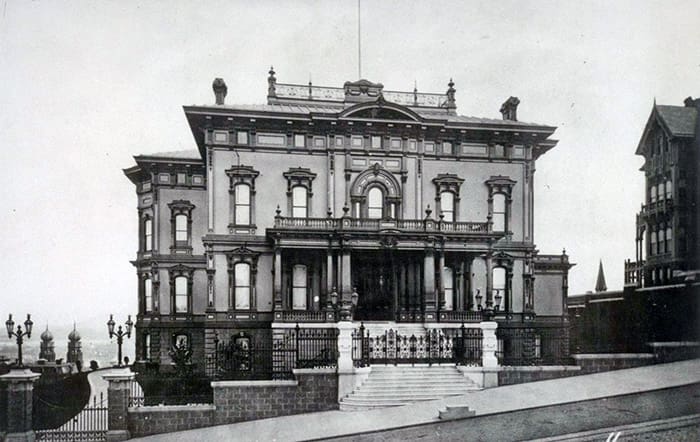
Leland Stanford mansion, Nob Hill
Then it was 35 miles south to the campus of Stanford, in Palo Alto.
Stanford had been founded by Leland Stanford, railroad magnate and former California governor, and his wife Jane, in honor of their son, Leland, Junior, who died from typhoid fever at age 16. The first classes were held in 1891.
Stanford's initial bequest was $5,000,000 and after his death in 1893, his wife donated another $11,000,000, assuring the ability of the school to grow into one of the great educational institutions in the country.
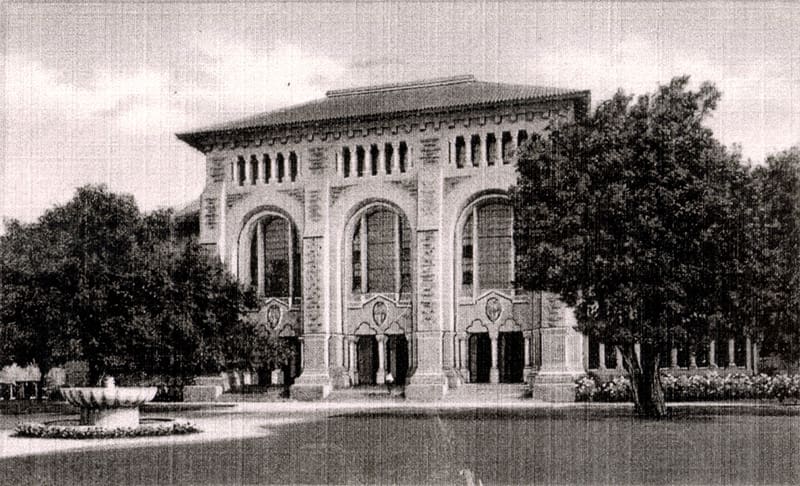
The Library at Stanford
The University had just completed a new football stadium when Centre arrived on the campus for a workout. The facility had been completed in just 132 days, held 60,000, and cost $573,470. The inaugural game had been played 5 weeks previously, a rather unhappy affair with the Cardinal losing badly to the California Bears, 42-7. The tuft on the practice field was in better condition that that of the new stadium, so the Colonels worked out there.
George Joplin, ever present, filed a story for his readers in Danville's "Messenger," and for the Louisville "Herald."
Did you ever see a band of youngsters at play after having been penned up in a house for several days? Well, the Centre College football warriors resembled a bunch of frolicsome kiddies after a quarantine in their workout at Leland Stanford University. The drill was the first thorough one in several days, and the boys reveled in it to the fullest.
They had begun to get mighty tired of the train, and welcomed with eagerness the feel of moleskins once again. Muscles stiffened by the tedious but pleasurable ride here were flexed in the snappy drill Coach Moran gave his charges at Palo Alto.
The boys were in uniform at 3:30 in the afternoon. They were a bit slow in getting warmed up, and had some difficulty hanging onto the slippery ball as there was a slight drizzle. Near the close of the practice session, they found their footing and were working true to form.
A large crowd of students and other spectators turned out and applauded the work of the squad. Tonight, the athletic officials of Stanford gave a dinner in honor of the Colonels. Nothing that would add to the comfort of the members of the party was overlooked by the University officials. After the practice, the team was shown about the new stadium which greatly resembles the Harvard horseshoe. After their showers, the men were taken on a motor tour around the college's 9,000 acre campus, which seems about the size of Danville.
The party was led through the library and the $2,000,000 church and chapel. A.E. Roth, college treasurer, described the points of special interest to the Colonels while in the chapel building. He announced that chapel attendance was non-compulsory. George Chinn announced that "any student who would cut chapel ought to be hung."
After a wonderful dinner, the squad was taken back to San Francisco and took the ferry back to Oakland. They entertained themselves by feeding the gulls which would fly in low and eat right out of their hands.
Swede Anderson, the trainer, insisted that he wanted to go through the "Golden Gate" before it closed and invited "Old Nero," Red Roberts, to come with him. "It may be your only chance. "
The "Cowdray" was coupled to the Southern Pacific "Lark" and is scheduled to pull out later tonight.
At the station, a reporter asked Bo what he thought about California playing Washington and Jefferson rather than Centre in the Rose Bowl. Bo diplomatically side stepped the question about why Centre was heading to San Diego rather than Pasadena.
The Centre great said that W&J is one of the trickiest teams on the Eastern fields, and one which can never be taken lightly.
All told, Centre's team appears to be all that is said of them. Mild-mannered off the gridiron, a clean husky bunch, but when on the field, playing with a clean fierceness that spells victory and football success.
